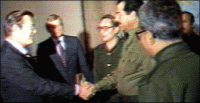forestal
I'm the Boss of Me
Bring back the good old days they say!
The Devil you know is better than the Devil you don't
BAGHDAD, April 8 -- In a garage filled with classic motorcycles, Khadim al-Jubouri stared at the four-year-old magazines he usually keeps tucked inside a wooden desk. All of them contained photographs of a lone, burly man wearing a black tank top and swinging a sledgehammer into the base of a tall, bronze statue of Saddam Hussein. The man was Jubouri.
Just days earlier, he might have been executed for his actions.
But it was April 9, 2003.
Crowds of chanting Iraqis, some clutching stones and sandals, swarmed Firdaus Square to deliver blows to the statue. Then, with the help of an American tank and a winch, it toppled, creating one of the defining images of the U.S.-led invasion. Over one photo of Jubouri, a headline reads: "The Fall of Baghdad."
"It achieved nothing," he said, after he had put away the magazines.
Four years after that moment, with violence besieging the country, Jubouri is concerned with neither benchmarks nor timelines, troop strengths nor withdrawal dates. What he cares most about is security and order, of which, he said, he has seen very little. He blames Iraq's Shiite-led government and its security forces, and wishes for a return of the era led by the man whose statue he helped tear down.
"We got rid of a tyrant and tyranny. But we were surprised that after one thief had left, another 40 replaced him," said Jubouri, who is a Shiite Muslim. "Now, we regret that Saddam Hussein is gone, no matter how much we hated him."
The Devil you know is better than the Devil you don't
BAGHDAD, April 8 -- In a garage filled with classic motorcycles, Khadim al-Jubouri stared at the four-year-old magazines he usually keeps tucked inside a wooden desk. All of them contained photographs of a lone, burly man wearing a black tank top and swinging a sledgehammer into the base of a tall, bronze statue of Saddam Hussein. The man was Jubouri.
Just days earlier, he might have been executed for his actions.
But it was April 9, 2003.
Crowds of chanting Iraqis, some clutching stones and sandals, swarmed Firdaus Square to deliver blows to the statue. Then, with the help of an American tank and a winch, it toppled, creating one of the defining images of the U.S.-led invasion. Over one photo of Jubouri, a headline reads: "The Fall of Baghdad."
"It achieved nothing," he said, after he had put away the magazines.
Four years after that moment, with violence besieging the country, Jubouri is concerned with neither benchmarks nor timelines, troop strengths nor withdrawal dates. What he cares most about is security and order, of which, he said, he has seen very little. He blames Iraq's Shiite-led government and its security forces, and wishes for a return of the era led by the man whose statue he helped tear down.
"We got rid of a tyrant and tyranny. But we were surprised that after one thief had left, another 40 replaced him," said Jubouri, who is a Shiite Muslim. "Now, we regret that Saddam Hussein is gone, no matter how much we hated him."

